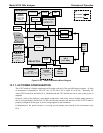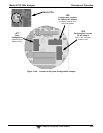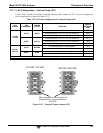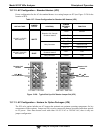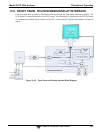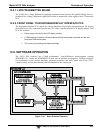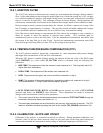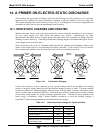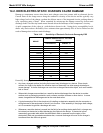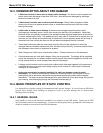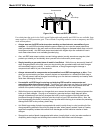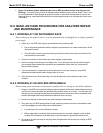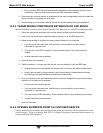
Model 9110T NOx Analyzer Principles of Operation
Teledyne Analytical Instruments 365
13.9.1. ADAPTIVE FILTER
The 9110T NO
X
analyzer software processes sample gas concentration data through a built-in adaptive
filter. Unlike other analyzers that average the output signal over a fixed time period, the 9110T averages
over a defined number of samples, with samples being about 8 seconds apart (reflecting the switching
time of 4 s each for NO and NO
X
). This technique is known as boxcar filtering. During operation, the
software may automatically switch between two different filters lengths based on the conditions at hand.
During constant or nearly constant concentrations, the software, by default, computes an average of the
last 42 samples, or approximately 5.6 minutes. This provides smooth and stable readings and averages
out a considerable amount of random noise for an overall less noisy concentration reading.
If the filter detects rapid changes in concentration the filter reduces the averaging to only 6 samples or
about 48 seconds to allow the analyzer to respond more quickly. Two conditions must be
simultaneously met to switch to the short filter. First, the instantaneous concentration must differ from
the average in the long filter by at least 50 ppb. Second, the instantaneous concentration must differ
from the average in the long filter by at least 10% of the average in the long filter
13.9.2. TEMPERATURE/PRESSURE COMPENSATION (TPC)
The 9110T software includes a feature that compensates for some temperature and pressure changes
that might affect measurement of NO and NO
X
concentrations.
When the TPC feature is enabled (default setting), the analyzer divides the value of the PMT output
signal (PMTDET) by a value called TP_FACTOR, which is calculated using the following four
parameters:
BOX TEMP: The temperature inside the analyzer’s case measured in K. This is typically about 5 K
higher than room temperature.
RCELL TEMP: The temperature of the reaction cell, measured in K.
RCEL: The pressure of the gas in the vacuum manifold, measured in in-Hg-A.
SAMP: The pressure of the sample gas before it reaches the reaction cell, measured in in-Hg-A.
This measurement is ~1 in-Hg-A lower than atmospheric pressure.
As RCEL TEMP, BOX TEMP, RCELL and SAMP pressure increase, the value of TP_FACTOR
increases and, hence, the PMTDET value decreases. These adjustments are meant to counter-act
changes in the concentrations caused by these parameters.
The current value of all four of these measurements are viewable as TEST FUNCTIONS through the
instrument’s front panel display (see Section 4.1.1).
The preset gain parameters are set at the factory and may vary from analyzer to analyzer. The TPC
feature is enabled or disabled by setting the value of the variable TPC_ENABLE (see Section 5.8).
13.9.3. CALIBRATION - SLOPE AND OFFSET
Calibration of the analyzer is performed exclusively in software. During instrument calibration, (see
Sections 9 and 10) the user enters expected values for zero and span via the front panel touchscreen
control and commands the instrument to make readings of calibrated sample gases for both levels.




